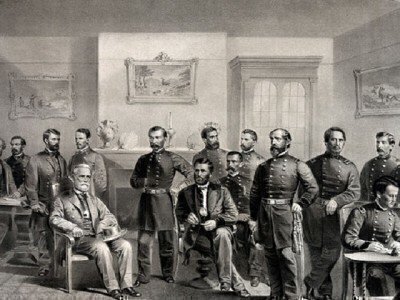On this day, Confederate General Robert E. Lee agreed to surrender his Army of Northern Virginia, marking a symbolic end to the Civil War on April 9, 1865.
 The overall Confederate surrender took place in stages over the following two months, with other Confederate armies reaching surrender agreements after Lee met with Union General Ulysses S. Grant at Appomattox Court House.
The overall Confederate surrender took place in stages over the following two months, with other Confederate armies reaching surrender agreements after Lee met with Union General Ulysses S. Grant at Appomattox Court House.
But the loss of Lee and the Army of Northern Virginia was a fatal blow to the Confederacy.
Lee’s troops had been besieged by Grant’s Union forces at Petersburg and Richmond for a 10-month period starting in June 1864. Lee used his considerable experience as a combat engineer to have his troops dig trenches to slow the Union advance.
But on April 1, 1865, Union forces led by General Phillip Sheridan took a critical transportation link at Five Forks, and Grant broke through the Petersburg defenses the following day.
Lee and the Army of Northern Virginia withdrew to the southwest harried by Grant’s forces. On April 6, about a quarter of Lee's army surrendered after it was cut off from Lee and surrounded by Union forces. The next day, Lee and Grant started corresponding about a possible surrender of the rest of the Army of Northern Virginia.
Grant said it was “my duty to shift from myself the responsibility of any further effusion of blood by asking of you the surrender of that portion of the Confederate States army known as the Army of Northern Virginia.” Lee then asked about surrender terms.
The two military leaders agreed to meet under a truce at the home of Wilmer McLean in Appomattox on the afternoon of April 9. A sharply dressed Lee and Lieutenant Colonial Charles Marshall arrived first, followed by a slightly disheveled Grant and his officers, a group that included Robert Todd Lincoln.
The generals had met once before during the Mexican-American War, and they briefly chatted about the experience.
Lee then asked Grant to write down the surrender terms, which allowed Lee’s officers to keep their sidearms and horses, and a similar provision was provided for Lee’s cavalry and artillery troops. All of Lee’s troops were to "be allowed to return to their homes, and not be disturbed by United States authority so long as they observe their paroles and the laws in force where they may reside." Grant also provided rations for the starved Confederate troops.
The generous surrender terms avoided potential trials of Confederate leaders and served as a blueprint for other surrenders that followed.
After the papers were signed, Lee and Grant shook hands. After Lee mounted his horse, Grant and his officers saluted Lee, who returned the gesture. Approximately, 28,000 Confederate soldiers laid down their weapons over the next three days and returned home.







